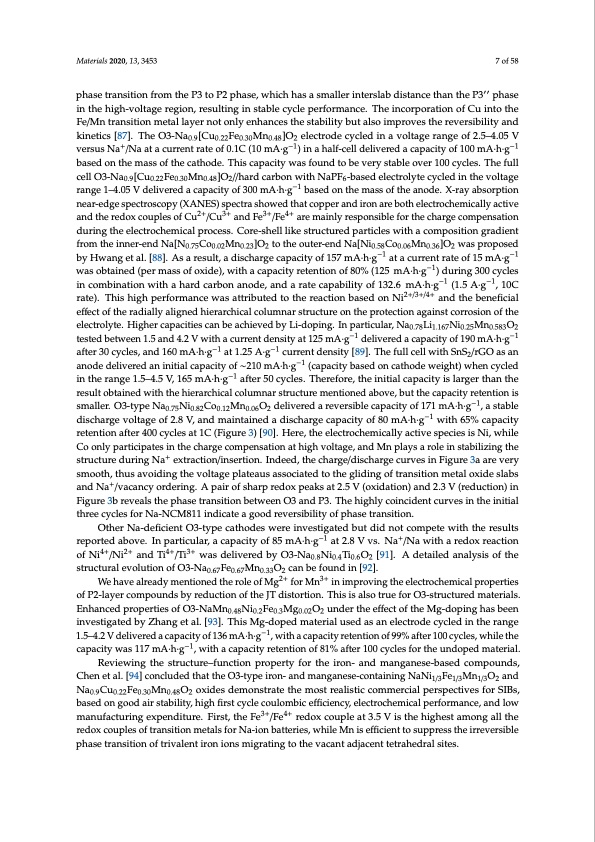
PDF Publication Title:
Text from PDF Page: 007
Materials 2020, 13, 3453 7 of 58 phase transition from the P3 to P2 phase, which has a smaller interslab distance than the P3′′ phase in the high-voltage region, resulting in stable cycle performance. The incorporation of Cu into the Fe/Mn transition metal layer not only enhances the stability but also improves the reversibility and kinetics [87]. The O3-Na0.9[Cu0.22Fe0.30Mn0.48]O2 electrode cycled in a voltage range of 2.5–4.05 V versus Na+/Na at a current rate of 0.1C (10 mA·g−1) in a half-cell delivered a capacity of 100 mA·h·g−1 based on the mass of the cathode. This capacity was found to be very stable over 100 cycles. The full cell O3-Na0.9[Cu0.22Fe0.30Mn0.48]O2//hard carbon with NaPF6-based electrolyte cycled in the voltage range 1–4.05 V delivered a capacity of 300 mA·h·g−1 based on the mass of the anode. X-ray absorption near-edge spectroscopy (XANES) spectra showed that copper and iron are both electrochemically active and the redox couples of Cu2+/Cu3+ and Fe3+/Fe4+ are mainly responsible for the charge compensation during the electrochemical process. Core-shell like structured particles with a composition gradient from the inner-end Na[N0.75Co0.02Mn0.23]O2 to the outer-end Na[Ni0.58Co0.06Mn0.36]O2 was proposed by Hwang et al. [88]. As a result, a discharge capacity of 157 mA·h·g−1 at a current rate of 15 mA·g−1 was obtained (per mass of oxide), with a capacity retention of 80% (125 mA·h·g−1) during 300 cycles in combination with a hard carbon anode, and a rate capability of 132.6 mA·h·g−1 (1.5 A·g−1, 10C rate). This high performance was attributed to the reaction based on Ni2+/3+/4+ and the beneficial effect of the radially aligned hierarchical columnar structure on the protection against corrosion of the electrolyte. Higher capacities can be achieved by Li-doping. In particular, Na0.78Li1.167Ni0.25Mn0.583O2 tested between 1.5 and 4.2 V with a current density at 125 mA·g−1 delivered a capacity of 190 mA·h·g−1 after 30 cycles, and 160 mA·h·g−1 at 1.25 A·g−1 current density [89]. The full cell with SnS2/rGO as an anode delivered an initial capacity of ∼210 mA·h·g−1 (capacity based on cathode weight) when cycled in the range 1.5–4.5 V, 165 mA·h·g−1 after 50 cycles. Therefore, the initial capacity is larger than the result obtained with the hierarchical columnar structure mentioned above, but the capacity retention is smaller. O3-type Na0.75Ni0.82Co0.12Mn0.06O2 delivered a reversible capacity of 171 mA·h·g−1, a stable discharge voltage of 2.8 V, and maintained a discharge capacity of 80 mA·h·g−1 with 65% capacity retention after 400 cycles at 1C (Figure 3) [90]. Here, the electrochemically active species is Ni, while Co only participates in the charge compensation at high voltage, and Mn plays a role in stabilizing the structure during Na+ extraction/insertion. Indeed, the charge/discharge curves in Figure 3a are very smooth, thus avoiding the voltage plateaus associated to the gliding of transition metal oxide slabs and Na+/vacancy ordering. A pair of sharp redox peaks at 2.5 V (oxidation) and 2.3 V (reduction) in Figure 3b reveals the phase transition between O3 and P3. The highly coincident curves in the initial three cycles for Na-NCM811 indicate a good reversibility of phase transition. Other Na-deficient O3-type cathodes were investigated but did not compete with the results reported above. In particular, a capacity of 85 mA·h·g−1 at 2.8 V vs. Na+/Na with a redox reaction of Ni4+/Ni2+ and Ti4+/Ti3+ was delivered by O3-Na0.8Ni0.4Ti0.6O2 [91]. A detailed analysis of the structural evolution of O3-Na0.67Fe0.67Mn0.33O2 can be found in [92]. We have already mentioned the role of Mg2+ for Mn3+ in improving the electrochemical properties of P2-layer compounds by reduction of the JT distortion. This is also true for O3-structured materials. Enhanced properties of O3-NaMn0.48Ni0.2Fe0.3Mg0.02O2 under the effect of the Mg-doping has been investigated by Zhang et al. [93]. This Mg-doped material used as an electrode cycled in the range 1.5–4.2 V delivered a capacity of 136 mA·h·g−1, with a capacity retention of 99% after 100 cycles, while the capacity was 117 mA·h·g−1, with a capacity retention of 81% after 100 cycles for the undoped material. Reviewing the structure–function property for the iron- and manganese-based compounds, Chen et al. [94] concluded that the O3-type iron- and manganese-containing NaNi1/3Fe1/3Mn1/3O2 and Na0.9Cu0.22Fe0.30Mn0.48O2 oxides demonstrate the most realistic commercial perspectives for SIBs, based on good air stability, high first cycle coulombic efficiency, electrochemical performance, and low manufacturing expenditure. First, the Fe3+/Fe4+ redox couple at 3.5 V is the highest among all the redox couples of transition metals for Na-ion batteries, while Mn is efficient to suppress the irreversible phase transition of trivalent iron ions migrating to the vacant adjacent tetrahedral sites.PDF Image | Electrode Materials for Sodium-Ion Batteries

PDF Search Title:
Electrode Materials for Sodium-Ion BatteriesOriginal File Name Searched:
materials-13-03453-v2.pdfDIY PDF Search: Google It | Yahoo | Bing
Salgenx Redox Flow Battery Technology: Salt water flow battery technology with low cost and great energy density that can be used for power storage and thermal storage. Let us de-risk your production using our license. Our aqueous flow battery is less cost than Tesla Megapack and available faster. Redox flow battery. No membrane needed like with Vanadium, or Bromine. Salgenx flow battery
| CONTACT TEL: 608-238-6001 Email: greg@salgenx.com | RSS | AMP |